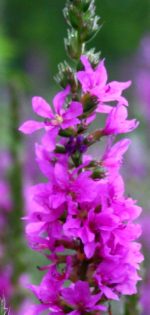Lythrum salicaria  Purple loosestrife is a herbaceous perennial and member of the loosestrife family, Lythraceae, that also includes pomegranate and crepe myrtle, but is not related to other plants called loosestrife that are in the primrose family. It is native to wetlands of Europe and Asia and was introduced into northeastern US in the 1800s for ornamental and medicinal uses but now occurs in all of the 48 contiguous states except Florida, Louisiana, Georgia, South Carolina, and Arizona . Plants like wet sites and can be found in wet meadows, marshes, river and stream banks, pond and lake edges, and ditches. Although a handsome garden plant its invasiveness is so severe that its sale is banned in several states.
Purple loosestrife is a herbaceous perennial and member of the loosestrife family, Lythraceae, that also includes pomegranate and crepe myrtle, but is not related to other plants called loosestrife that are in the primrose family. It is native to wetlands of Europe and Asia and was introduced into northeastern US in the 1800s for ornamental and medicinal uses but now occurs in all of the 48 contiguous states except Florida, Louisiana, Georgia, South Carolina, and Arizona . Plants like wet sites and can be found in wet meadows, marshes, river and stream banks, pond and lake edges, and ditches. Although a handsome garden plant its invasiveness is so severe that its sale is banned in several states.
Description: Growing two to ten feet tall, purple loosestrife has an upright slightly hairy stem that is reddish purple and somewhat square in cross-section. The lanceolate leaves occur in in twos or threes, clasp the stem, and are slightly hairy and one to four inches long. The purplish pink flowers have five to seven petals and appear in slender spikes throughout most of the summer giving way in the fall to capsules with many small seeds. A single plant can produce up to three million seeds in one year. Plants spread by seed and underground stems.
Control: Improving the drainage and thereby making the soil less hospitable to the plant is effective. Pulling, cutting, and mowing plants where possible can proved effective control if repeated every two weeks until roots stop sprouting. If digging or pulling the plants try to remove all the root to reduce resprouting. The herbicide glyphosate is effective but dangerous to the whole wetland and should be used with extreme caution. Large infestations have been successfully managed by biological controls involving the introduction of insects that destroy the plant.